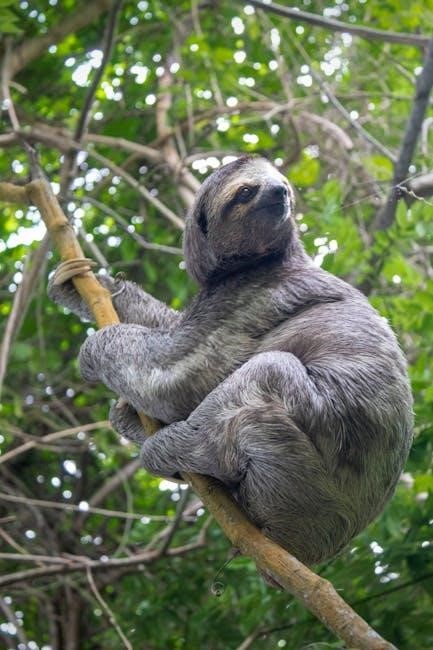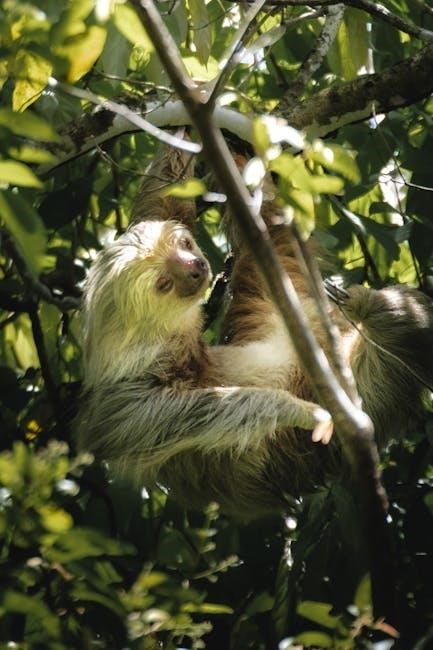
Origin and History of the Story

Goldilocks and the Three Bears is a classic fairy tale with a rich history, evolving over time through various adaptations and interpretations in children’s literature, remaining a beloved story globally.
1.1 The Original Narrative
The original story of Goldilocks and the Three Bears revolves around a curious girl named Goldilocks who stumbles upon the home of three bears—a great big Papa Bear, a medium-sized Mama Bear, and a tiny Baby Bear. While the bears are out for a walk, Goldilocks enters their house, drawn by the enticing aroma of porridge. She samples the porridge from three bowls, declaring one “too hot,” another “too cold,” and the last “just right.” Her curiosity continues as she sits in their chairs and ultimately sleeps in Baby Bear’s bed. The story unfolds with the bears’ return, leading to a confrontation with Goldilocks, who flees in fright. This narrative has become a timeless tale, teaching lessons about curiosity, boundaries, and the consequences of one’s actions.
1.2 Evolution Over Time
Over the years, the story of Goldilocks and the Three Bears has undergone significant changes, adapting to cultural and societal shifts. Originally, the tale featured an old woman and three bears, with Goldilocks introduced later to appeal to younger audiences. The narrative has been modified in various adaptations, with some versions softening the character of Goldilocks to make her more relatable and less mischievous. Illustrations have also played a crucial role in shaping the story’s identity, with artists like Gerda Muller creating iconic visuals. Additionally, the story has been translated into multiple languages and adapted into films, stage plays, and even educational materials, ensuring its enduring popularity. These transformations highlight the tale’s versatility and its ability to remain relevant across generations.

Main Characters
The story features Goldilocks, a curious and mischievous girl, and the Three Bears: Father Bear, Mother Bear, and Baby Bear, each with distinct personalities.

2.1 The Three Bears
The Three Bears are the core family in the story, each with unique traits. Father Bear is large and authoritative, often depicted with a deep voice. Mother Bear is caring and nurturing, ensuring the household runs smoothly. Baby Bear is small, innocent, and playful, representing youth and vulnerability. Together, they symbolize a typical family structure, emphasizing unity and togetherness. Their characteristics make them relatable and endearing to readers, while contrasting with Goldilocks’ mischievous nature. The bears’ distinct personalities add depth to the narrative, teaching children about family dynamics and individual differences. Their roles in the story highlight the importance of cooperation and the consequences of unexpected interruptions in their peaceful lives.
2.2 Goldilocks
Goldilocks is the central human character in the story, known for her curiosity and boldness. She is often portrayed as a young girl with golden hair, which gives her the name “Goldilocks.” Her mischievous nature leads her to explore the bears’ house, where she samples their porridge, sits in their chairs, and sleeps in Baby Bear’s bed. Goldilocks’ actions are driven by her curiosity and a sense of adventure, which often lands her in trouble. Despite her intrusive behavior, she is often depicted as a relatable and endearing character, representing the natural inquisitiveness of children. Her role in the story serves as a moral lesson about respecting others’ property and the consequences of one’s actions. Goldilocks’ character has become iconic in children’s literature, symbolizing both innocence and mischief. Her interactions with the Three Bears form the heart of the narrative, making her a memorable figure in the tale.

The Plot
Goldilocks enters the bears’ house, tastes their porridge, sits in their chairs, and sleeps in Baby Bear’s bed, leading to a surprising confrontation when the bears return home.
3.1 Goldilocks Discovers the House
One sunny day, while wandering through the forest, Goldilocks stumbled upon a charming house belonging to the three bears. The inviting aroma of porridge wafted through the air, enticing her curiosity. With a gentle knock on the door and no response, she decided to explore inside, unaware of the adventure awaiting her. The cozy home was neatly arranged, with porridge cooling on the table, sparking her interest. Her curiosity led her to venture further, setting the stage for a series of events that would unfold unexpectedly.
3.2 Tasting the Porridge
Curiosity piqued, Goldilocks approached the table where three bowls of porridge sat. She tasted the first, belonging to Father Bear, and found it too hot. The second, Mother Bear’s, was too cold. Finally, she tried Baby Bear’s porridge, declaring it “just right.” She ate the entire bowl, satisfying her hunger. The porridge tasting marked the beginning of her meddling, as she proceeded to explore further, unaware of the chaos she would create. This act of tasting the porridge showcased her impulsive nature and set the stage for subsequent events in the story.
3.3 Sitting in the Chairs
After tasting the porridge, Goldilocks’ curiosity led her to the living room, where she spotted three chairs. She sat in the first, belonging to Father Bear, but found it too hard. Next, she tried Mother Bear’s chair, only to discover it was too soft. Finally, she settled into Baby Bear’s chair, which she declared “just right.” Satisfied, she rocked gently, but the chair, unable to withstand her weight, broke. Startled, Goldilocks quickly moved on, unaware of the growing mess she had created. Her actions, though seemingly harmless, continued to disrupt the bears’ orderly home, leading to further discoveries and chaos.
3.4 Sleeping in Baby Bear’s Bed
After exploring the chairs, Goldilocks ventured upstairs, where she discovered the bears’ bedrooms. She opened the door to Baby Bear’s room and found his bed, which immediately caught her attention. Curious as ever, she decided to rest and climbed into the bed. The bed felt just right, and soon she fell fast asleep. Unbeknownst to her, the bears were on their way home, exhausted from their walk. When they arrived, they were shocked to find their porridge had been tasted, their chairs had been sat in, and now a stranger was sleeping in Baby Bear’s bed. This discovery set the stage for the climactic confrontation, as the bears’ peaceful day turned into a chaotic encounter with the curious intruder.
3.5 The Confrontation
The bears returned home, exhausted from their walk, only to find their house in disarray. Father Bear noticed his porridge had been tasted, Mother Bear saw her chair had been sat in, and Baby Bear was shocked to see his bed had been slept in. Suddenly, they heard a noise upstairs and rushed to find Goldilocks fast asleep in Baby Bear’s bed. Startled by the bears’ presence, Goldilocks woke up with a fright. She saw the three angry bears staring at her and quickly realized she was in trouble. Panicked, she jumped out of the window and ran away as fast as she could, never looking back. The bears, though shaken, were relieved that the chaos had ended and their peace was restored.

Themes and Lessons
Goldilocks and the Three Bears explores themes of curiosity, responsibility, and consequences, teaching children about boundaries, respect for others’ property, and the importance of honesty and integrity.
4.1 Moral Lessons
Goldilocks and the Three Bears imparts valuable moral lessons, emphasizing the importance of respecting others’ property and the consequences of curiosity. The story teaches children about honesty, responsibility, and the need to apologize for mistakes. It highlights the significance of boundaries and the repercussions of trespassing, making it a timeless tale for moral education. The narrative encourages empathy and understanding, showing how Goldilocks learns from her actions. These lessons are conveyed through simple, relatable scenarios, making the story an effective tool for teaching ethical behavior to young readers. The moral framework of the tale remains universal, resonating across cultures and generations, ensuring its relevance in modern educational contexts.

4.2 The Theme of Curiosity
Curiosity is a central theme in “Goldilocks and the Three Bears,” driving the plot and character development. Goldilocks’s inquisitive nature leads her to explore the bears’ house, taste their porridge, sit in their chairs, and sleep in Baby Bear’s bed. Her actions illustrate how curiosity can lead to both positive discoveries and negative consequences. While her curiosity is natural and often praised as a trait, the story shows how it must be balanced with respect for others’ property. The tale serves as a cautionary story, teaching children the importance of boundaries and the potential repercussions of unchecked curiosity. By exploring these dynamics, the story provides a timeless lesson about the double-edged nature of curiosity and the need for self-control.

Cultural Impact
Goldilocks and the Three Bears has become a cultural icon, inspiring countless adaptations in media, literature, and education, while remaining a timeless tale cherished across generations worldwide.
5.1 Adaptations in Media
Goldilocks and the Three Bears has been adapted into various media forms, including films, TV series, animations, and stage plays, each offering unique interpretations of the classic tale. The story’s simplicity and timeless themes make it a favorite for filmmakers and creators. Animated versions, such as those by Disney and other studios, have brought the characters to life in vibrant colors and engaging storylines. Additionally, the tale has been adapted into interactive media, such as video games and virtual reality experiences, allowing audiences to immerse themselves in the story. These adaptations not only entertain but also introduce the story to new generations, ensuring its enduring popularity. The availability of PDF versions further enhances its accessibility, making it a cultural phenomenon that transcends traditional storytelling.
5.2 Educational Uses
Goldilocks and the Three Bears is widely used in educational settings to teach children valuable lessons and skills. The story’s moral themes, such as respecting others’ property and the consequences of curiosity, make it a popular choice for character education. PDF versions of the story are often used in classrooms to enhance reading comprehension and vocabulary development. Teachers incorporate the tale into lesson plans to discuss sequencing events, predicting outcomes, and analyzing characters. The story’s simplicity and relatable plot also make it ideal for early readers. Additionally, the British Council and other educational organizations have utilized the story to promote language learning and cultural understanding. Its availability in PDF formats ensures easy access for educators and students worldwide, making it a versatile tool for fostering learning and creativity in young minds;

PDF Versions and Availability
6.1 Popular PDF Editions
Several popular PDF editions of Goldilocks and the Three Bears are widely available. These include classic tale versions with vibrant illustrations, such as those by Gerda Muller, as well as educational adaptations designed for early readers.
These PDFs are often free or affordably priced, allowing parents, educators, and children to enjoy the timeless story conveniently. The availability of multiple editions ensures that readers can choose the version that best suits their preferences and needs.
6.2 How to Access the PDF
Additionally, educational institutions and publishers, such as the British Council and Oxford University Press, offer downloadable PDFs. Simply search for “Goldilocks and the Three Bears PDF” on search engines or e-book platforms.
Many websites provide free access to the story in PDF format, while others may require a subscription or a one-time purchase. Ensure to download from reputable sources to guarantee quality and safety. This convenient format allows readers to enjoy the classic tale on various devices, making it ideal for both personal reading and educational purposes.
